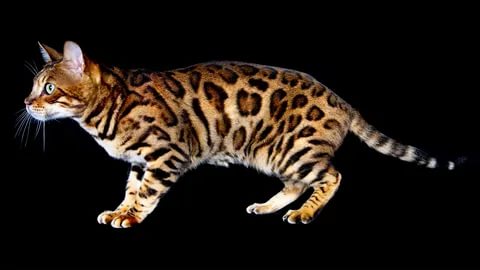What is a Bengal Cat?
The Bengal feline is a long, strong, medium-to enormous estimated feline, with a wide head and gag, high cheekbones, and articulated bristle cushions. The eyes are round and wide, with dull markings around the eyes (mascara) and the ears little and adjusted at the tips. The beauty of a wilderness feline is held as one of the positive qualities, alongside the capacity to move unobtrusively and with secrecy. The back legs are somewhat more than the front legs, making the rear end somewhat higher than the shoulders, and accentuating the Bengal's wild-feline appearance. The Bengal's solid, athletic form is one of its most characterizing highlights; it is rarely sensitive.
The Bengal stands apart among felines for its lavish, thick, and surprisingly delicate coat. The particular panther like spots on the Bengal house feline can be irregular, adjusted evenly with rosettes that structure a half circle, or in a marbled example. The favored tones are dark or earthy colored spotted, and dark or earthy colored marbled, however raisers have likewise designed Bengals that are snow spotted (white), and snow marbled. The spots ought to be in sharp difference to the foundation tone.
Bengals regularly have a quality called sparkling, which causes the coat to seem to have been tidied with gold or pearl. While this normally happening attribute upgrades the regular excellence of the Bengal, and is liked by certain individuals, it not given exceptional inclination in the show ring.
Bengal Cat Personality and Temperament
In view of its non domesticated ancestry, the Bengal is regularly thought to be hard to deal with, yet the opposite is valid. Reproducers demand that the Bengal can be subdued effectively and has a loving character, however it's anything but a lap feline. In any case, it appreciates human organization, and will regularly remain nearby to its relatives. The Bengal feline variety especially appreciates the organization of kids, since its fiery nature makes it partial to messing around.
One of the qualities the Bengal house feline holds from its wild lineage is the chasing nature - for little land creatures, yet additionally for water abiding animals. The Asian panther has sharpened the capacity to fish in the wild, and your homegrown Bengal might just convey this attribute in the more perky structure, swimming close by of you, scrubbing down, or simply playing in the sink.
A high energy feline, you will need to make certain to give your Bengal a lot of play time, and remember that most high energy felines like to leap to high areas. You will need to keep flimsy items out of damages route and off of open racks; even, and maybe particularly, the most elevated racks.
History and Background
The Bengal feline variety is solitary in the feline extravagant as the lone fruitful matching of a wild feline with a homegrown feline. There is some narrative proof that pairings of the Asian panther feline with homegrown felines had been endeavored before the 1960s, yet the genuine beginning of the Bengal breed started decisively during the 1970s, when novice raiser Jean Sudgen, of California, turned into the beneficiary of a gathering of felines that had been reproduced for use in hereditary testing. Dr. Willard Centerwall of Loyola University had been trying Asian Leopards for their fractional resistance to cat leukemia, and started cross reproducing them with homegrown felines for conceivable hereditary feasibility in vaccination improvement.
Instead of obliterate the felines after the program was finished, Dr. Centerwall looked for proper homes for his felines. Since Ms. Sudgen had a genuine interest in rearing Asian panther half breeds, she decided not to take the entirety of the felines, rather zeroing in on those felines that were demonstrating an inclination for homegrown demeanor alongside the ideal spotting designs.
As far as concerns her, Ms. Sudgen had started her first investigations in feline hybridization while contemplating hereditary qualities at UC Davis during the 1940s. Whenever gave the chance to work with Dr. Centerwall's Asian panthers and their half and halves, she took to it with excitement, and despite the fact that Dr. Centerwall was completely steady of Ms. Sudgen's undertakings, the equivalent couldn't be said for the feline extravagant local area. Most reproducers were steadfastly against rearing a wild feline with a homegrown, and right up 'til the present time, the Cat Fanciers Association keeps on denying enrollment to the Bengal due to its wild bloodline, however numerous different affiliations have incorporated the Bengal breed since the 1980s, including The International Cat Association.
Ms. Sudgen, who had at this point remarried and taken the name Mill, had been advised that the posterity of her intersections would be sterile, and this demonstrated valid for the guys that came about because of the matings, however she would be advised to karma with the female half breeds. Before she could completely drench herself in her new reproducing program, in any case, Ms. Factory required a fitting male feline to cross with her female Asian panther half and halves. Feeling that neither the Mau, Burmese, or Abyssinian unadulterated varieties were hereditarily sufficient, she opened her net more extensive, and in 1982, her understanding took care of when a guardian for the New Delhi Zoo, in India, directed her toward a panther like road feline that was living all alone in the rhinoceros' display at the zoo. Albeit the feline was wild, it end up being a magnificent mate for her half and half females, and inside the space of years Ms. Plant had her fruitful, however as yet youngster, reproducing program well in progress.






Post a Comment